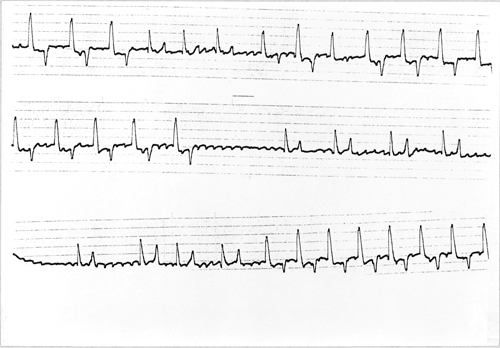Difference between revisions of "Equine Internal Medicine Q&A 12"
Ggaitskell (talk | contribs) |
|||
| Line 21: | Line 21: | ||
*Serum cardiac isoenzymes were also evaluated. <br> | *Serum cardiac isoenzymes were also evaluated. <br> | ||
All these tests were normal. | All these tests were normal. | ||
| − | |l2= | + | |l2=Cardiomyopathy |
|q3=What would be a logical treatment regimen for this horse assuming the test(s) in the answer to part 2 is/are normal? | |q3=What would be a logical treatment regimen for this horse assuming the test(s) in the answer to part 2 is/are normal? | ||
|a3= | |a3= | ||
Revision as of 15:07, 8 July 2011
| This question was provided by Manson Publishing as part of the OVAL Project. See more Equine Internal Medicine questions |
This ECG was obtained from a horse with acute onset of exercise intolerance. Auscultation revealed an irregular rhythm with a rate of 40–50bpm, but periods of a rapid (about 80bpm) regular rhythm were also heard. There were no murmurs.
| Question | Answer | Article | |
| What is the rhythm? | Atrial fibrillation with paroxysmal ventricular tachycardia. |
Link to Article | |
| What other diagnostic procedure(s) should be performed? |
All these tests were normal. |
Link to Article | |
| What would be a logical treatment regimen for this horse assuming the test(s) in the answer to part 2 is/are normal? |
After 24 hours, the ventricular tachycardia had resolved, but the atrial fibrillation was still present. The atrial fibrillation was successfully converted to sinus rhythm after several doses of quinidine sulphate had been given by nasogastric tube. |
Link to Article | |
